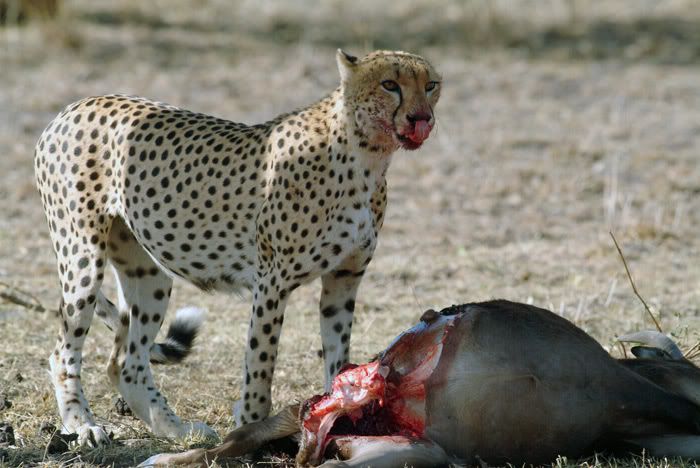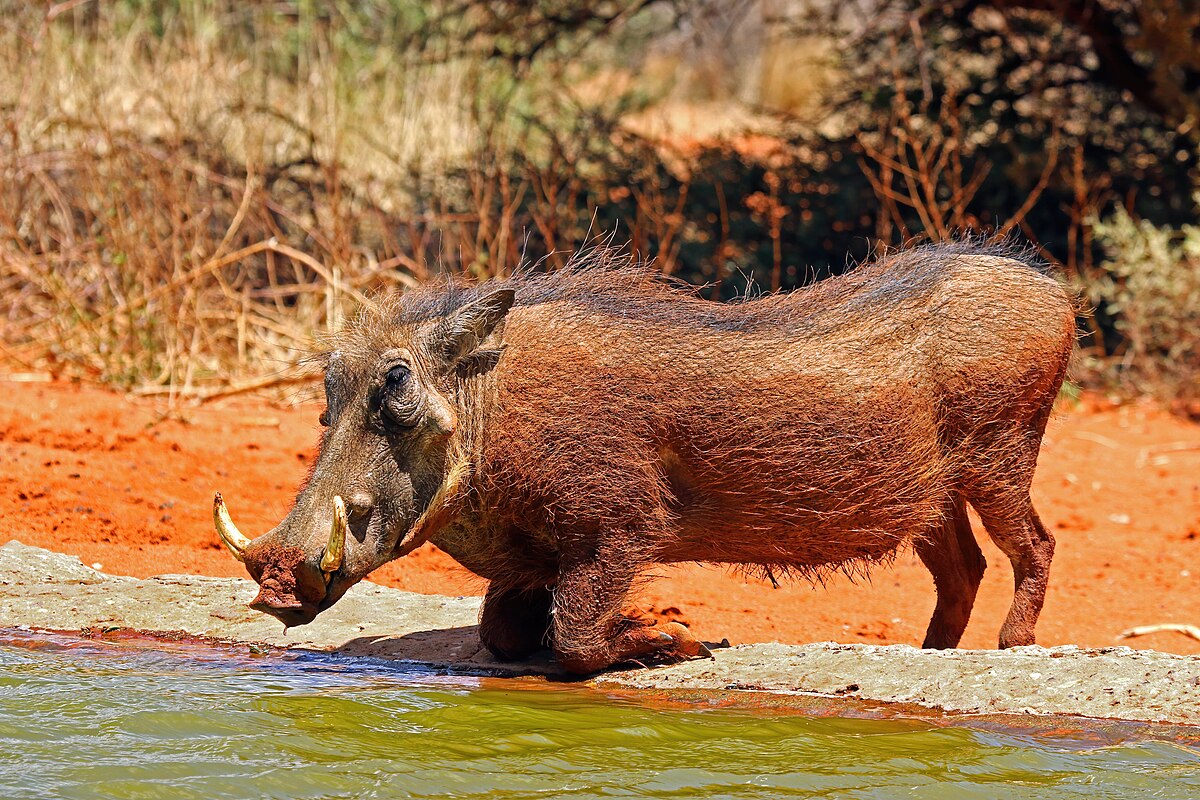Post by dinosauria101 on Jun 17, 2019 9:01:15 GMT 5
Cheetah - Acinonyx jubatus
The cheetah (Acinonyx jubatus) is a large-sized feline (family Felidae) inhabiting most of Africa and parts of the Middle East. The cheetah is the only extant member of the genus Acinonyx, most notable for modifications in the species' paws. As such, it is the only felid with non-retractable claws and pads that, by their scope, disallow gripping (therefore cheetahs cannot climb vertical trees, although they are generally capable of reaching easily accessible branches). The cheetah, however, achieves by far the fastest land speed of any living animal—between 112 and 120 km/h (70 and 75 mph) in short bursts covering distances up to 500 m (1,600 ft), and has the ability to accelerate from 0 to over 100 km/h (62 mph) in three seconds. The cheetah's chest is deep and its waist is narrow. The coarse, short fur of the cheetah is tan with round black spots measuring from 2 to 3 cm (0.79 to 1.2 in) across, affording it some camouflage while hunting. There are no spots on its white underside, but the tail has spots, which merge to form four to six dark rings at the end. The tail usually ends in a bushy white tuft. The cheetah has a small head with high-set eyes. Black "tear marks" running from the corner of its eyes down the sides of the nose to its mouth keep sunlight out of its eyes and aid in hunting and seeing long distances. Although it can reach high speeds, its body cannot stand long distance running, because it is more suited to short bursts of speed. The adult cheetah weighs from 35 to 72 kg (77 to 160 lb). Its total head-and-body length is from 110 to 150 cm (43 to 59 in), while the tail can measure 60 to 84 cm (24 to 33 in) in length. Cheetahs are 66 to 94 cm (26 to 37 in) tall at the shoulder. Males tend to be slightly larger than females and have slightly bigger heads, but there is not a great variation in cheetah sizes and it is difficult to tell males and females apart by appearance alone. Compared to a similarly sized leopard, the cheetah is generally shorter-bodied, but is longer tailed and taller (it averages about 90 cm (35 in) tall) and so it appears more streamlined.

Common Warthog - Phacochoerus africanus
Common warthogs are found in open and wooded savannas, grass-steppes, and semi-deserts in Africa. Common warthogs prefer open areas and avoid rainforest and severe desert. They are found on Kilimanjaro up to an elevation of 3000 m and along coastal regions of Africa. Common warthogs often utlilize formerly wooded areas that have been cleared for pastures. Common warthogs weigh 50 to 150 kg with females being 15 to 20 percent lighter than males. Head and body length is 900 to 1500 mm. Shoulder height ranges from 635 to 850 mm. Common warthogs have large upper tusks that are 255 to 635 mm long in males and 152 to 255 mm long in females. As their name suggests, warthogs have three pairs of facial warts, comprised of cartilaginous connective tissue. The three types of warts are: 1) the suborbital warts, which may grow as long as 15 cm in males; 2) the preorbital warts, which do not develop as much in females; and 3) the submaxillary warts, which have white bristles.
Mass : 50 to 150 kg (110 to 330 lbs)
Length : 900 to 1500 mm (35.43 to 59.06 in)

Credit to Wikipedia
The cheetah (Acinonyx jubatus) is a large-sized feline (family Felidae) inhabiting most of Africa and parts of the Middle East. The cheetah is the only extant member of the genus Acinonyx, most notable for modifications in the species' paws. As such, it is the only felid with non-retractable claws and pads that, by their scope, disallow gripping (therefore cheetahs cannot climb vertical trees, although they are generally capable of reaching easily accessible branches). The cheetah, however, achieves by far the fastest land speed of any living animal—between 112 and 120 km/h (70 and 75 mph) in short bursts covering distances up to 500 m (1,600 ft), and has the ability to accelerate from 0 to over 100 km/h (62 mph) in three seconds. The cheetah's chest is deep and its waist is narrow. The coarse, short fur of the cheetah is tan with round black spots measuring from 2 to 3 cm (0.79 to 1.2 in) across, affording it some camouflage while hunting. There are no spots on its white underside, but the tail has spots, which merge to form four to six dark rings at the end. The tail usually ends in a bushy white tuft. The cheetah has a small head with high-set eyes. Black "tear marks" running from the corner of its eyes down the sides of the nose to its mouth keep sunlight out of its eyes and aid in hunting and seeing long distances. Although it can reach high speeds, its body cannot stand long distance running, because it is more suited to short bursts of speed. The adult cheetah weighs from 35 to 72 kg (77 to 160 lb). Its total head-and-body length is from 110 to 150 cm (43 to 59 in), while the tail can measure 60 to 84 cm (24 to 33 in) in length. Cheetahs are 66 to 94 cm (26 to 37 in) tall at the shoulder. Males tend to be slightly larger than females and have slightly bigger heads, but there is not a great variation in cheetah sizes and it is difficult to tell males and females apart by appearance alone. Compared to a similarly sized leopard, the cheetah is generally shorter-bodied, but is longer tailed and taller (it averages about 90 cm (35 in) tall) and so it appears more streamlined.

Common Warthog - Phacochoerus africanus
Common warthogs are found in open and wooded savannas, grass-steppes, and semi-deserts in Africa. Common warthogs prefer open areas and avoid rainforest and severe desert. They are found on Kilimanjaro up to an elevation of 3000 m and along coastal regions of Africa. Common warthogs often utlilize formerly wooded areas that have been cleared for pastures. Common warthogs weigh 50 to 150 kg with females being 15 to 20 percent lighter than males. Head and body length is 900 to 1500 mm. Shoulder height ranges from 635 to 850 mm. Common warthogs have large upper tusks that are 255 to 635 mm long in males and 152 to 255 mm long in females. As their name suggests, warthogs have three pairs of facial warts, comprised of cartilaginous connective tissue. The three types of warts are: 1) the suborbital warts, which may grow as long as 15 cm in males; 2) the preorbital warts, which do not develop as much in females; and 3) the submaxillary warts, which have white bristles.
Mass : 50 to 150 kg (110 to 330 lbs)
Length : 900 to 1500 mm (35.43 to 59.06 in)

Credit to Wikipedia





